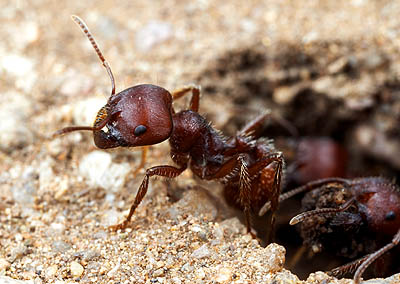
How does a newly speciating ant prevent backcrossing with its parental species? A new study in the journal Evolution by Schwander et al. investigates four hypotheses using the Pogonomyrmex rugosus/barbatus hybrid speciation system, finding support for three of them. Apparently the daughter species maintains its genetic distinctness from a parent species by mating at a different time, mating preferentially with its own species, and by having a much lowered ability to produce viable offspring.
In my opinion, the story of these hybrid harvester ant species is among the most interesting pieces of evolutionary research in the last decade. If you aren't familiar with it, it's worth reading up on. An ancient hybridization between two common harvester ant species, P. rugosus and P. barbatus, spun off a pair of daughter species that are each stuck with the odd position of having to mate with the other daughter species in order to produce worker ants. Otherwise, the colonies produce only queens and aren't viable. Stories like these serve as reminders for just how complicated the origin of species can be.
Source: Schwander, T., Suni, S.S., Helms-Cahan, S., Keller, L. (2008) Mechanisms of Reproductive Isolation Between an Ant Species of Hybrid Origin and One of its Parents. doi:10.1111/j.1558-5646.2008.00387.x
photo: a worker of a hybrid daughter species emerges from her nest at the Southwestern Research Station in Portal, AZ.

totally, all of nature is like that. everything is inter-connected and when you take one piece out of the puzzle, nothing makes sense. send this article to the people who don't believe in evolution!!
Hi Ed. Thanks for your comment. The thing is, over a dozen technical articles about evolution- much like this one- are published *every day*. I don't think people realize just how productive evolutionary theory is.